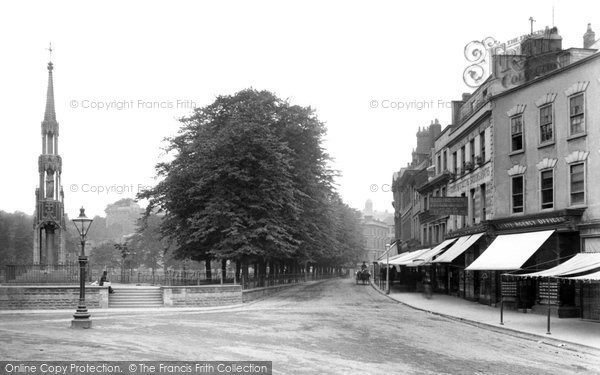Tales Of College Green
A Memory of Bristol.
This shows College Green and its grand posh upmarket shops, at a time in the past when parking wasn't a problem.
Many famous people lived round the Green over the years including Mary Robinson; actress and mistress of the Prince of Wales, Sam Worrall; the town clerk taken in by the fraudulent Princess Caraboo and involved in the terrible Bristol Bridge massacre, and poets Samuel Taylor Coleridge and Robert Southey In the eighteenth century it was a very fashionable residential quarter. By this century, it was a pleasant park surrounded by trees and railings.
They once buried their dead here and made a few groats on the side by letting out the land for cattle and for a rope walk (a place where strands were twisted into rope). But after an access row with the brothers of St Mark opposite ((now the Lord Mayor's Chapel), the canons were told they could carry on using the land as a burial ground, but only if they left it flat with no markers - and the grass was to be used solely for covering the floors of churches and not for cattle.
The land was regarded as sanctuary where those accused of treason could go to escape the law, but this ended in the early fifteenth century when Pope Alexander announced that all traitors were enemies to the Christian faith. By 1634, the Green (now attached to a cathedral rather than an abbey of course) was in a dismal state.
It was regularly churned up by sledges carrying clothes to dry on Brandon Hill (a privilege granted by Elizabeth I). There was also a Corporation whipping post there, and locals used the Green for stop-ball and other games. The Archbishop ordered the place cleaned up, but it was two years before the cathedral got round to it.
The Green was often used as a parade ground for trained bands ( militia ) as well as a playground, and there were gardens there as well. In 1709, the Corporation contributed 40 to another improvement scheme, this time to provide fencing and replace a double row of trees blown down in the great storm of 1703.
The work was carried out but the dean still refused to maintain the Green and, by 1756, the Corporation had to find another 40 guineas to replace the turf and paths. This, however, led to another juicy bit of Bristol scandal.
The city's ancient High Cross had been moved from High Street to the Green in 1733. It made a nice centrepiece, but the corporation and cathedral authorities decided it was in the way of strollers on their new paths.
So the cross was taken down, and stored in the cathedral cloisters until 1764 when the dean gave it away to Henry Hoare, owner of Stourhead, near Warminster in the county of Wiltshire.
Add your comment
You must be signed-in to your Frith account to post a comment.
Add to Album
You must be signed in to save to an album
Sign inSparked a Memory for you?
If this has sparked a memory, why not share it here?




Comments & Feedback
Be the first to comment on this Memory! Starting a conversation is a great way to share, and get involved! Why not give some feedback on this Memory, add your own recollections, or ask questions below.